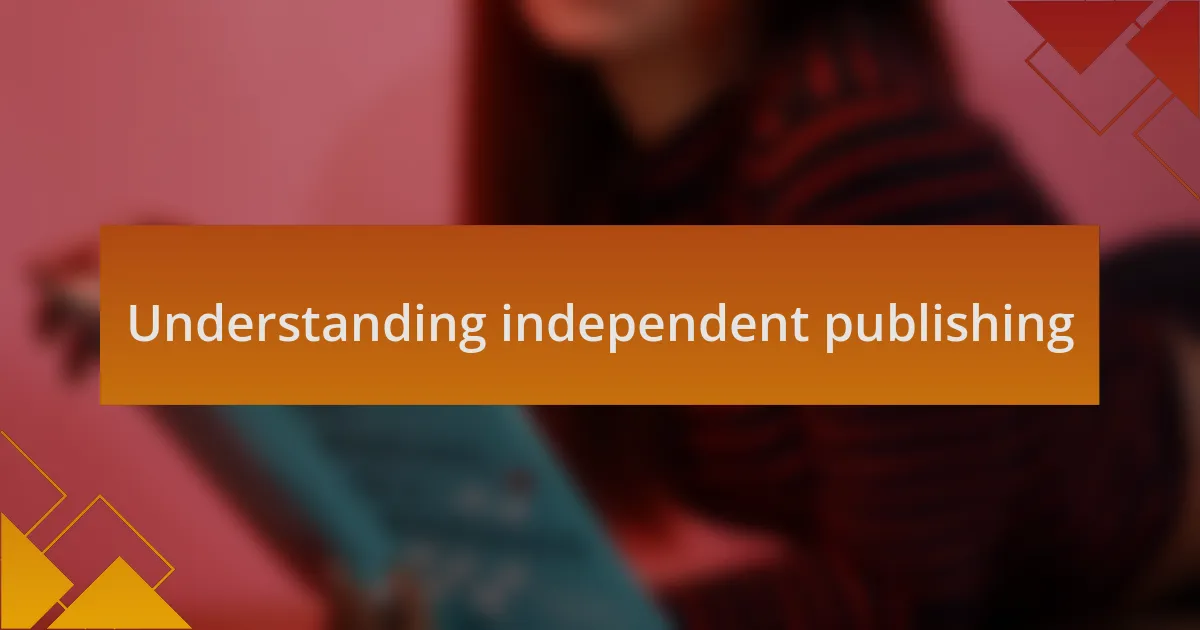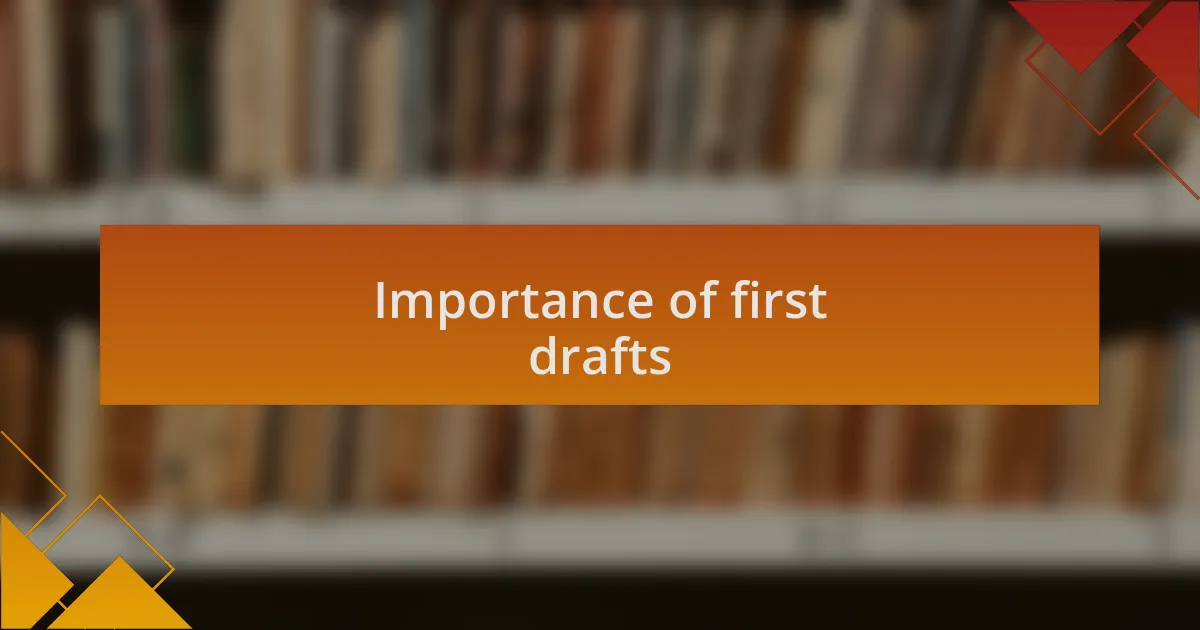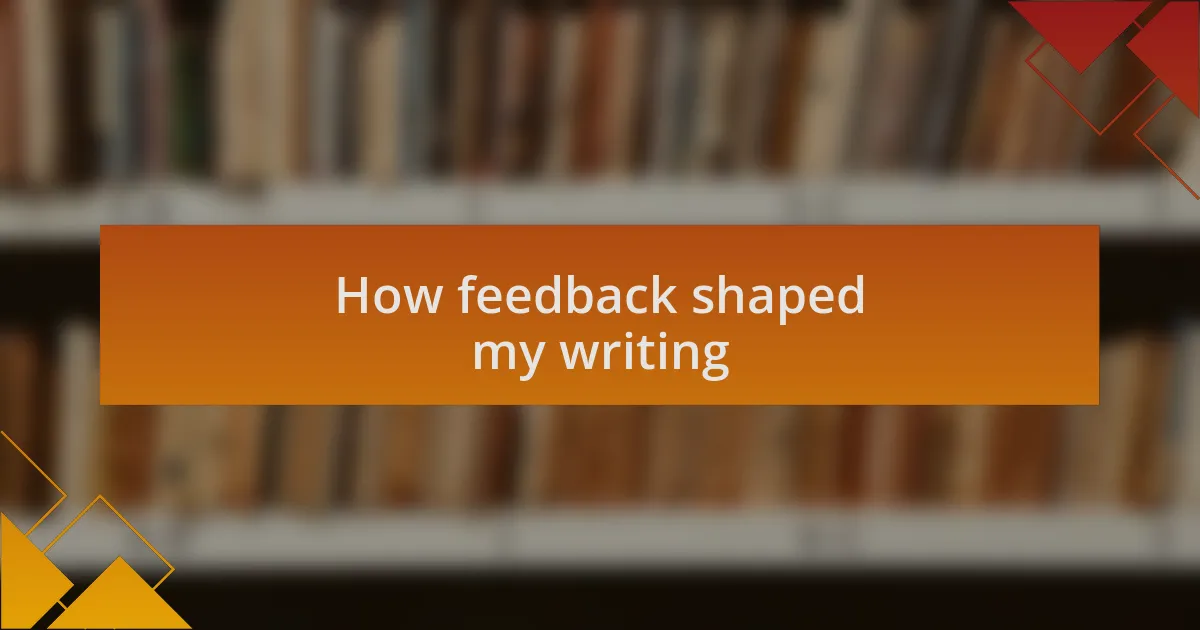Key takeaways:
- Independent publishing allows authors to maintain creative control, enhancing their engagement with the writing process.
- First drafts serve as a foundation for growth, capturing initial ideas that can evolve through revision.
- Feedback is crucial for understanding and improving one’s writing, helping to identify flaws and deepen emotional resonance.
- Implementing structured revision strategies, such as setting goals and reading drafts aloud, can significantly enhance the clarity and quality of writing.

Understanding independent publishing
Independent publishing is a world where authors can take the reins of their creative journey. I remember the moment I decided to self-publish my first book. It was both thrilling and terrifying—was I ready to put my work out there without the backing of a traditional publisher?
Navigating this landscape taught me the importance of wearing multiple hats. I became not just a writer, but also an editor, marketer, and even a graphic designer. Each role added depth to my understanding of the publishing process. Do I believe those experiences enriched my writing? Absolutely; they forced me to consider every aspect of how my book would resonate with readers.
One insight I carry with me is the sheer control that independent publishing offers. There’s nothing quite like choosing your cover design or setting your release date according to your vision. It made me wonder: what could I achieve if I fully embraced this freedom? That question has transformed how I approach every new writing project since then.

Importance of first drafts
Creating a first draft is like laying the foundation for a house; it’s where everything begins. In my experience, the first draft often resembles a messy brainstorm rather than a polished manuscript. I remember feeling overwhelmed by the chaos on the page, but I quickly realized that this raw, unfiltered version was essential for capturing my initial thoughts and ideas.
One of the profound lessons I learned is that first drafts pave the way for growth. During my own writing journey, I discovered that each subsequent revision revealed layers of meaning I hadn’t initially considered. There were moments where I thought certain sections were solid, only to realize through editing that I could express the same idea more powerfully with just a tweak here and there. Isn’t it fascinating how a rough draft can lead to those magical breakthroughs?
Moreover, a finished first draft serves as a tangible reminder of progress. It can be daunting to see that blank page, but once you’ve created something—no matter how imperfect—it feels like a victory. I used to think that a first draft had to be perfect, but I learned that its purpose is simply to exist. Embracing that mindset transformed my writing process, allowing me to approach revisions with a sense of curiosity rather than fear.

Common mistakes in first drafts
When I look back at my early first drafts, I often cringe at how frequently I overloaded them with details. I remember pouring everything I could think of onto the page—every idea, every thought—thinking that more would equate to better. Instead, it muddled my message. Have you ever felt that way too? Less can be more, and clarity often shines through simplicity.
Another pitfall I encountered was neglecting character development, especially in fiction writing. I would craft a plot filled with action yet forget to breathe life into my characters. It dawned on me that readers connect to the emotional journeys of well-rounded characters. So, I began asking myself how each character truly felt and reacted in various situations, rather than merely assigning them roles in the story.
Lastly, I learned the importance of perspective—quite literally. Many of my drafts suffered from inconsistent points of view, leaving readers confused about whose eyes they were seeing the world through. I had to remind myself that maintaining a steady perspective can significantly enhance the reader’s experience. Did I remember to check if I was in the protagonist’s head or wandering off into another character’s thoughts? Keeping a close eye on this transformed my stories immensely.

Learning from my first draft
Looking back at my first drafts, I realized that one of the most valuable lessons was learning to trust the revision process. There was a time when I felt my first draft had to be perfect, leading me to spend countless hours agonizing over every word. I vividly remember sitting at my desk, feeling completely stuck because I was more focused on perfection than creativity. It hit me how freeing it is to let ideas flow in the first draft, knowing I can always refine them later.
Another crucial insight was recognizing the power of feedback. Early on, I would keep my drafts close, fearing criticism. However, when I finally shared a draft with a trusted friend, their fresh perspective illuminated a few awkward sections I had missed. Have you experienced a similar moment? I learned that constructive criticism can be a pathway to growth rather than a deterrent.
Finally, I discovered the importance of emotional resonance in my writing. My first drafts often felt flat because I was holding back my feelings, afraid they might be perceived as too raw or personal. Once I started letting my guard down and infusing my experiences into the narrative, it transformed not only my drafts but also my connection with readers. It’s astonishing how vulnerability can create an authentic voice that readers want to engage with.

Strategies for improving drafts
One effective strategy I’ve adopted for improving my drafts is implementing a systematic revision process. After completing a draft, I set it aside for a day or two, allowing my mind to reset. When I return, I often find areas that need clarity or stronger arguments. Have you ever noticed how a little distance can change your perspective on your work? It certainly helps me identify gaps that I might have missed in the heat of writing.
Another powerful approach involves reading my drafts aloud. This simple technique has completely transformed how I perceive my writing. Hearing the words can reveal awkward phrasings or unnatural rhythms that might not be as apparent when reading silently. I remember one instance where reading aloud brought attention to a convoluted sentence, prompting me to simplify it. Can you imagine how many readers may be tripped up by similar lines?
Furthermore, I’ve found that creating specific revision goals for each draft significantly enhances my focus. For instance, I might decide to concentrate solely on improving dialogue in one round and then tackle character development in the next. Setting clear objectives not only streamlines the revision process but also helps me track my progress more effectively. How have you structured your revisions? I believe tailored goals can turn the daunting task of editing into a more manageable and rewarding experience.

How feedback shaped my writing
Receiving feedback was a turning point for me, and it often feels like having a trusted guide on my writing journey. Early on, I shared my first draft with a fellow writer who pointed out sections that were flat or confusing. One particular comment struck me—”Your character needs to have a voice.” It made me realize how much I had overlooked the essence of my character, and it sparked a determination to enhance their individuality. Have you ever experienced that lightbulb moment when someone else’s perspective shifts your understanding entirely?
I vividly remember a moment when I received critiques from a writing group. They highlighted a subplot I thought was strong but, to my surprise, found lackluster. That insight forced me to dig deeper into the motivations and conflicts of my characters, ultimately enriching the plot. I felt a mix of vulnerability and gratitude; isn’t it incredible how constructive criticism can breathe new life into your work?
Another significant lesson came from early readers who emphasized the importance of emotional depth. One reader shared how they connected with my protagonist’s struggles, and that feedback pushed me to explore the character’s internal landscape further. It sparked a desire in me to ensure my writing resonates on an emotional level, creating a richer experience for my readers. Have you pondered how others perceive the emotions you convey? It’s a reminder that our work is often best understood through the eyes of those we wish to engage.